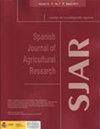椰子树(Cocos nucifera L.)茎部内照射农药移位模型
IF 0.8
4区 农林科学
Q3 AGRICULTURE, MULTIDISCIPLINARY
引用次数: 1
摘要
研究目的:建立一种模拟杀虫剂在椰树体内迁移的数学模型。同时对水和椰浆中的农药残留进行了评价。研究领域:数据来自巴西塞尔希佩州伊塔波拉纳达阿朱达市伊塔波拉纳试验田的椰子植物。材料与方法:采用经典的分散-平流方程对柱头进行建模,分析农药位点-液系数和阻滞因子对椰子果实易位及其植物检疫行为和污染风险的影响。将环丙康唑、嘧菌酯、乐果、吡虫啉、甲螨灵、噻虫嗪等农药注射到椰树茎中。采用QuEChERS方法对纸浆、水和椰汁中农药残留的提取方法进行了改进。主要结果:模拟结果表明:(1)农药乐果、甲螨灵和噻虫灭是在椰树茎液中表现出最大转运潜力的活性成分;(ii)吡虫啉和甲螨灵在柱头向上迁移的速度快于阿维菌素和环丙康唑,后者向椰树地上迁移的速度较慢。在色谱分析中,经评价间隔后,注射了农药的椰子树的水和椰子果肉样品中没有农药残留。研究亮点:提出的模型使我们能够观察到易位与农药在椰树茎中的吸收成反比。本文章由计算机程序翻译,如有差异,请以英文原文为准。
Modeling pesticide translocation injected by endotherapy into the stem of coconut tree (Cocos nucifera L.)
Aim of study: To present a mathematical model to simulate the translocation of pesticides injected into coconut trees. Pesticide residues in water and coconut pulp were also evaluated.
Area of study: The data were obtained in coconut plants of the Itaporanga Experimental Field, located in the Municipality of Itaporanga d'Ajuda, Sergipe State, Brazil.
Material and methods: To estimate the effect of pesticide site-sap coefficients and retardation factors on translocation and its phytosanitary behavior and risk of contamination of coconut fruits, the stipe was modeled by a classic dispersion-advection equation. The pesticides cyproconazole, azoxystrobin, dimethoate, imidacloprid, metalaxyl, and thiamethoxam were injected into the coconut palm stipe. The method used to extract pesticide residues from pulp, water and coconut sap samples was based on the QuEChERS methodology with modifications.
Main results: Simulations showed that (i) the pesticides dimethoate, metalaxyl, and thiamethoxan were the active ingredients showing the greatest potential for translocation in the sap of the coconut tree stem; (ii) the pesticides imidacloprid and metalaxyl translocated upward in the stipe, and more rapidly than pesticides abamectin and cyproconazole, which moved slower to the aerial part of coconut plants. In chromatography analysis, no pesticide residues were quantified in water and coconut fruit pulp samples of coconut trees injected with pesticides, after the evaluated intervals.
Research highlights: The proposed model allowed us to observe that the translocation is inversely proportional to the sorption of the pesticide in the stem of coconut trees.
求助全文
通过发布文献求助,成功后即可免费获取论文全文。
去求助
来源期刊

Spanish Journal of Agricultural Research
农林科学-农业综合
CiteScore
2.00
自引率
0.00%
发文量
60
审稿时长
6 months
期刊介绍:
The Spanish Journal of Agricultural Research (SJAR) is a quarterly international journal that accepts research articles, reviews and short communications of content related to agriculture. Research articles and short communications must report original work not previously published in any language and not under consideration for publication elsewhere.
The main aim of SJAR is to publish papers that report research findings on the following topics: agricultural economics; agricultural engineering; agricultural environment and ecology; animal breeding, genetics and reproduction; animal health and welfare; animal production; plant breeding, genetics and genetic resources; plant physiology; plant production (field and horticultural crops); plant protection; soil science; and water management.
 求助内容:
求助内容: 应助结果提醒方式:
应助结果提醒方式:


